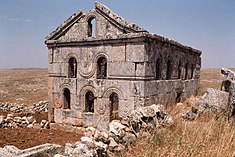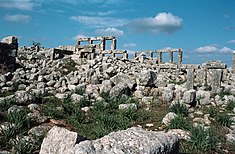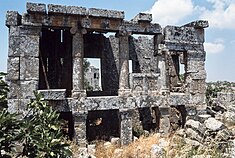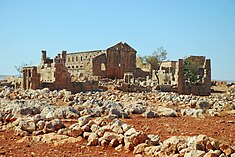| UNESCO World Heritage Site | |
|---|---|
 View of Serjilla View of Serjilla | |
| Location | Limestone Massif, Syria |
| Includes | |
| Criteria | Cultural: (iii)(iv)(v) |
| Reference | 1348 |
| Inscription | 2011 (35th Session) |
| Endangered | 2013–present |
| Area | 12,290 ha (30,400 acres) |
| Coordinates | 36°20′3″N 36°50′39″E / 36.33417°N 36.84417°E / 36.33417; 36.84417 |
  | |
The Dead Cities (Arabic: المدن الميتة) or Forgotten Cities (Arabic: المدن المنسية) are a group of 700 abandoned settlements in northwest Syria between Aleppo and Idlib. Around 40 villages grouped in eight archaeological parks situated in north-western Syria provide an insight into rural life in Late Antiquity and during the Byzantine period. Most of the villages, which date from the 1st to 7th centuries, were abandoned between the 8th and 10th centuries. The settlements feature the well-preserved architectural remains of buildings such as dwellings, pagan temples, churches, cisterns and bathhouses. Important dead cities include the Church of Saint Simeon Stylites, Dahis, Serjilla, Ruweiha and al Bara.
The Dead Cities are situated in an elevated area of limestone known as Limestone Massif. These ancient settlements cover an area 20–40 km (12–25 mi) wide and some 140 km (87 mi) long. The Massif includes three groups of highlands: the first is the northern group of Mount Simeon and Mount Kurd; the second middle group is the group of Harim Mountains; the third southern group is the group of Zawiya Mountain.
History

Chris Wickham, in the authoritative survey of the post-Roman world, "Framing the Early Middle Ages" (2006) argues that these were settlements of prosperous peasants which have few or no specifically urban features. The impressive remains of domestic architecture are the result of the prosperity of peasants who benefited from a strong international trade in olive oil at the end of Antiquity.
Another argument is that these were prosperous cities that flourished because they were located along major trade routes in the Byzantine Empire, and not merely prosperous peasant settlements. After conquest by the Arabs, the trade routes changed, and as a result, these towns lost the majority of the business which fostered their economies. On this view, settlers eventually abandoned their towns and headed for other cities that were flourishing under the Arabs and the Umayyads as increasing urbanisation took its toll.
The ancient villages of the Dead Cities illustrate the transition from the ancient pagan world of the Roman Empire to Byzantine Christianity.
The Dead Cites were inscribed as a UNESCO World Heritage Site in 2011, under the name of "Ancient Villages of Northern Syria". The Dead Cities were the 1348th site to be added to UNESCO's World Heritage Site list. The Dead Cities have been on the Endangered UNESCO list since 2013, meaning the site was not endangered for only two years.
Before the Syrian Civil War most sites had become easily accessible, the majority of the dead cities were well-preserved and tourists could access the sites quite freely, though some of the Dead Cities are quite difficult to reach without a guide (there is a guidebook by Abdallah Hadjar with a detailed map that is useful for finding the lesser known sites; The Church of St Simeon Stylites and Other Archaeological Sites in the Mountains of Simeon and Halaqa. However, the Syrian Civil War has caused Syrian refugees to flee to these sites in hopes of finding shelter. In various areas, refugees have repurposed the stone ruins located on these sites to rebuild their livelihoods.
Archeological sites
Dead cities and archeological sites in Limestone Massif include Church of Saint Simeon Stylites, Serjilla, Bara, Basufan, Barisha, Qalb Loze, Barad, Cyrrhus, Turmanin, Banabil, Kafr Aruq, Kafr Dariyan, Babuline, Hazarin, Jarada, Maghara, Shinan, Farkya, Ein Laruz, Ebla, Deir Sunbul, Al-Dana, Sarmada and Al-Dana.
Mount Simeon, Mount Kurd and Mount Ḥalqa
| Name |
Image | Coordinates | Governorate | Notes |
|---|---|---|---|---|
| Barad (Arabic: براد) |

|
36°23′8″N 36°53′57″E / 36.38556°N 36.89917°E / 36.38556; 36.89917 (Barad, Syria) | Aleppo | An ancient settlement, located 32 km (20 mi) west of Aleppo, has many old basilicas; for example, the Saint Julianus Maronite monastery (399-402 AD) where the shrine of Saint Maron is located, and a basilica at the northern part of the village built in 561. |
| Barjaka or Burj Suleiman village (Arabic: برجكة) |

|
36°19′25.80″N 36°53′35.71″E / 36.3238333°N 36.8932528°E / 36.3238333; 36.8932528 (Barjaka) | Aleppo | Located 26 km (16 mi) northwest of Aleppo. The site has remnants of an old hermit tower and a well-preserved chapel from the 6th century. |
| Basufan (Arabic: باصوفان) |

|
36°20′26.69″N 36°52′33.11″E / 36.3407472°N 36.8758639°E / 36.3407472; 36.8758639 (Basufan) | Aleppo | |
| Batuta (Arabic: بطوطة) |

|
36°18′21″N 36°53′14″E / 36.30583°N 36.88722°E / 36.30583; 36.88722 (Batuta) | Aleppo | Village founded in the 4th century CE. By the 6th century, it had two churches and more than twelve other stone buildings. |
| Baziher (Arabic: بازيهر) |
36°19′7″N 36°52′29″E / 36.31861°N 36.87472°E / 36.31861; 36.87472 (Baziher) | Aleppo | ||
| Benastur Monastery (Arabic: بنستور) |

|
36°18′12.00″N 36°55′23.00″E / 36.3033333°N 36.9230556°E / 36.3033333; 36.9230556 (Benastur) | Aleppo | |
| Churches of Sheikh Suleiman village (Arabic: كنائس شيخ سليمان) |

|
36°16′24.00″N 36°54′36.00″E / 36.2733333°N 36.9100000°E / 36.2733333; 36.9100000 (Sheikh Suleiman) | Aleppo | Located 28 km (17 mi) west of Aleppo, is notable for its three ancient churches: a ruined church located at the centre of the village, a well-preserved southern basilica which was built in 602, and the Church of the Virgin Mary which belongs to the late fifth century and is considered one of the most beautiful churches in northern Syria. There is a hermit tower in the northern side of the village. |
| Church of Saint Simeon Stylites (Deir Semaan) (Arabic: دير سمعان) |

|
36°19′35.00″N 36°50′01.00″E / 36.3263889°N 36.8336111°E / 36.3263889; 36.8336111 (Deir Semaan) | Aleppo | One of the most celebrated ecclesiastical monuments in Syria and among the oldest standing Christian churches in the world. It is located about 35 km (22 mi) northwest of Aleppo. |
| Cyrrhus (Arabic: سيروس – نبي هوري) |

|
36°44′39″N 36°57′33″E / 36.74417°N 36.95917°E / 36.74417; 36.95917 (Cyrrhus) | Aleppo | An ancient city located 65 km (40 mi) north of Aleppo, is the site of Saints Cosmas and Damian Church (commonly known as Nabi Houri church), as well as a Roman amphitheatre and two old Roman bridges. |
| Deir Amman churches (Arabic: دير عمان) |
36°12′8″N 36°49′18″E / 36.20222°N 36.82167°E / 36.20222; 36.82167 (Deir Amman) | Aleppo | ||
| Deir Mishmish Church (Arabic: كنيسة دير مشمش) |

|
36°27′47″N 36°55′1″E / 36.46306°N 36.91694°E / 36.46306; 36.91694 (Deir Mishmish) | Aleppo | |
| Deir Turmanin (Arabic: دير ترمانين) |

|
36°14′30″N 36°49′24″E / 36.24167°N 36.82333°E / 36.24167; 36.82333 (Deir Turmanin) | Idlib | The ruins of the Byzantine monastery of Deir Turmanin are built around a paved courtyard containing two cisterns, a sarcophagus and several tombs. They include a building that housed the monks' dormitories, and the large basilica built around 480 AD. |
| Fafertin Church (Arabic: كنيسة فافرتين) |
36°19′13.79″N 36°54′26.41″E / 36.3204972°N 36.9073361°E / 36.3204972; 36.9073361 (Fafertin) | Aleppo | A half-ruined Late Roman basilica dates to 372 AD; it is located 22 km (14 mi) northwest of Aleppo. According to the Aleppine historian Abdallah Hajjar, Fafertin Basilica is among the oldest dated churches in the world. | |
| Kafr Kira settlement in Burj Heidar village (Arabic: كفر كيرا في برج حيدر) |

|
36°20′36.05″N 36°54′09.08″E / 36.3433472°N 36.9025222°E / 36.3433472; 36.9025222 (Kafr Kira) | Aleppo | Located 24 km (15 mi) northwest of Aleppo, has many half-ruined Christian structures dating back to the fourth and sixth centuries. |
| Kafr Lab (Arabic: كفر لاب) |
36°20′08.09″N 36°53′26.79″E / 36.3355806°N 36.8907750°E / 36.3355806; 36.8907750 (Kafr Lab) | Aleppo | ||
| Kafr Lusein (Arabic: كفر لوسين) |
36°15′19.88″N 36°42′42.03″E / 36.2555222°N 36.7116750°E / 36.2555222; 36.7116750 (Kafr Lusein) | Aleppo | ||
| Kafr Nabu (Arabic: كفر نابو) |

|
36°21′36.54″N 36°54′28.88″E / 36.3601500°N 36.9080222°E / 36.3601500; 36.9080222 (Kafr Nabu) | Aleppo | Located 29 km (18 mi) west of Aleppo, is an Assyrian settlement of the ninth century BC and the site of a Roman temple which was converted into a church. There are also well-preserved residential buildings from the fifth and sixth centuries. |
| Kalota Castle and churches (Arabic: كالوطة) |

|
36°21′18.22″N 36°56′33.51″E / 36.3550611°N 36.9426417°E / 36.3550611; 36.9426417 (Kalota) | Aleppo | Located 20 km northwest of Aleppo. The castle was originally built as a Roman temple during the 2nd century AD. After converting to Christianity, the temple was turned into a basilica within the 5th century. As a result of the wars between the Hamadanids and the Byzantine Empire, the church was turned into a castle during the 10th century. There are two well-preserved churches near the castle: the eastern church built in 492 and the western church of the 6th century. |
| Kharab Shams Basilica (Arabic: خرب شمس) |

|
36°20′22.0″N 36°56′34.0″E / 36.339444°N 36.942778°E / 36.339444; 36.942778 (Kharab Shams Basilica) | Aleppo | One of the oldest best-preserved Christian structures in the Levant dates to the fourth century CE. The Byzantine church is located 21 km (13 mi) northwest of Aleppo. |
| Kimar, near Basuta village (Arabic: كيمار) |

|
36°25′25.3″N 36°53′45.4″E / 36.423694°N 36.895944°E / 36.423694; 36.895944 (Kimar) | Aleppo | Located 35 km (22 mi) northwest of Aleppo, is a fifth-century CE village of the Late Roman and Byzantine eras; it has many well-preserved churches, towers and old water cisterns. |
| Mushabbak Basilica (Arabic: المشبك) |
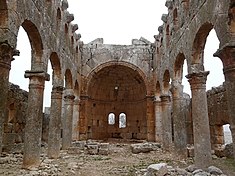
|
36°15′17.00″N 36°53′01.00″E / 36.2547222°N 36.8836111°E / 36.2547222; 36.8836111 (Mushabbak Basilica) | Aleppo | A well-preserved church from the second half of the fifth century (around 470), is located 25 km (16 mi) west of Aleppo, near the town of Daret A'zzeh. |
| Qatura (Arabic: قاطورة) |
36°18′02.71″N 36°49′48.34″E / 36.3007528°N 36.8300944°E / 36.3007528; 36.8300944 (Qatura) | Aleppo | ||
| Refade (Arabic: رفادة) |

|
36°18′57″N 36°49′19″E / 36.31583°N 36.82194°E / 36.31583; 36.82194 (Refade) | Idlib | |
| Sargible (Arabic: سرجبلا) |

|
36°14′17″N 36°42′59″E / 36.23806°N 36.71639°E / 36.23806; 36.71639 (Sargible) | Idlib | |
| Set al-Roum (Arabic: ست الروم) |

|
36°18′37″N 36°50′3″E / 36.31028°N 36.83417°E / 36.31028; 36.83417 (Set al-Roum) | Aleppo | |
| Sheikh Barakat (Arabic: الشيخ بركات) |
36°16′40″N 36°49′18″E / 36.27778°N 36.82167°E / 36.27778; 36.82167 (Sheikh Barakat) | Aleppo | ||
| Sinkhar historic settlement (Arabic: سنخار) |
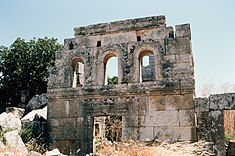
|
36°17′52.00″N 36°54′30.00″E / 36.2977778°N 36.9083333°E / 36.2977778; 36.9083333 (Sinhar) | Aleppo | Locally known as Simkhar, is located 24 km (15 mi) northwest of Aleppo in an isolated valley. The village was inhabited between the second and seventh centuries. Its Basilica is among the oldest churches in Syria and dates back to the fourth century, while the nearby chapel is sixth century. |
| Sugane village (Arabic: صوغانة) |
36°26′11.5″N 36°55′40.0″E / 36.436528°N 36.927778°E / 36.436528; 36.927778 (Sugane) | Aleppo | Located 40 km (25 mi) northwest of Aleppo, is home to two half-ruined churches and old water cisterns. | |
| Surqaniya village (Arabic: سرقانيا) |

|
36°18′59.00″N 36°54′02.00″E / 36.3163889°N 36.9005556°E / 36.3163889; 36.9005556 (Surqanya) | Aleppo | Located 23 km (14 mi) northwest of Aleppo, preserves the remains of an old Byzantine settlement with a half-ruined sixth-century chapel. |
| Taladah Church and Monastery (Arabic: تل عادة) |
36°15′5″N 36°48′4″E / 36.25139°N 36.80111°E / 36.25139; 36.80111 (Taladah) | Idlib | ||
| Taqla (Arabic: تقلا) |

|
36°19′09.96″N 36°50′51.03″E / 36.3194333°N 36.8475083°E / 36.3194333; 36.8475083 (Taqla) | Aleppo | |
| Zarzita (Arabic: زرزيتا) |

|
36°17′34.24″N 36°48′03.48″E / 36.2928444°N 36.8009667°E / 36.2928444; 36.8009667 (Zarzita) | Aleppo |
Harim Mountains (Mount Bārīshā and Mount A'lā)
Mount Zāwiya
See also
References
- Burns, Ross., Monuments of Syria: An Historical Guide, p. 109
- UNESCO. "Ancient Villages of Northern Syria". Retrieved 2011-10-30.
- Hubbard, Ben (February 15, 2022) . "Fleeing a Modern War, Syrians Seek Refuge in Ancient Ruins". The New York Times.
- "Roman ruins become home for Syrian refugees". The New Arab. 9 February 2015.
- "Syria Photo Guide". Archived from the original on 2017-05-14. Retrieved 2017-02-22.
- "الخارطة التفاعلية للمواقع الأثرية المتضررة". www.dgam.gov.sy. Archived from the original on July 15, 2020. Retrieved October 27, 2019.
- "Walking through the ruins". Jamahir News (in Arabic). Archived from the original on 2012-03-08.
- "Aleppo Fafertin Church". Esyria.sy. Retrieved 2013-06-10.
- "Aleppo: Kalota village". Esyria.sy. Archived from the original on 2016-08-23. Retrieved 2013-06-10.
- "Kalota Church". Qenshrin. Retrieved 2013-06-10.
- "Kharab Shams in history". Esyria.sy. 2008-12-13. Retrieved 2013-06-10.
External links
![]() Media related to Dead cities at Wikimedia Commons
Media related to Dead cities at Wikimedia Commons
- Ancient Villages of Northern Syria, are inscribed on the UNESCO world heritage list, in 2011 and on the List of World Heritage in Danger in 2013.
- Pictures of four dead cities
| World Heritage Sites in Syria | |
|---|---|
|














